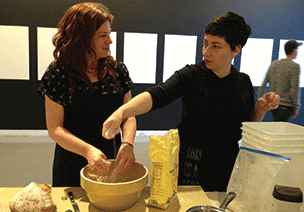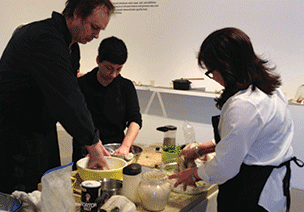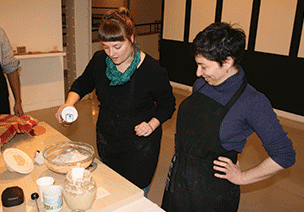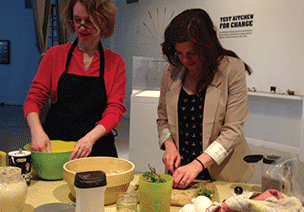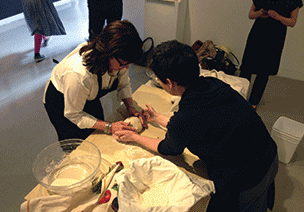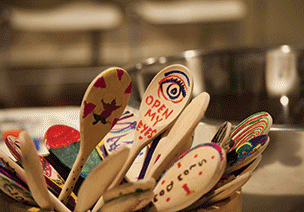
an essay
“Thank you for doing this! What a wonderful way to bring people together!” These words were written on a note handed to me by a gentleman in a black apron, dusted with flour. He was beaming. The paper for the note was torn from an old leaflet at the historic Lovely Lane Church in Baltimore. This church was where the second bread-making event for the Test Kitchen for Change took place in January,2013. I have kept this note. It makes me happy to think that my efforts can make some difference.
I began baking my own bread three years earlier after returning home from a trip to Germany. I grew up in the Ukraine and never thought much about bread. It was there daily, fresh at the bakery: dark round loaves of rye and bricks of whole wheat Borodincky, peppered with cracked coriander seeds. As a new immigrant, the quality of bread was not my top priority. But being reminded of good old taste, I decided to recreate a loaf of pungent Dark Ukrainian Rye.
First, I found out that the main ingredient
of the authentic bread is sourdough starter, something that was a mystery to me.
After a few on-line searches, I learned how
to capture the starter from the air in
Owings Mills, MD—my new home. This home-grown starter consists of many yeast cultures and is different from the mono-culture, commercial, factory-made yeast. The starter turned out to be easy to maintain and share. Friends and family complimented me on my bread.
A few hundred loaves and a couple years later, I realized that teaching people about bread-making would be a worthy thesis subject and a fulfilling journey for a designer, which led me to create an educational platform: Test Kitchen for Change.
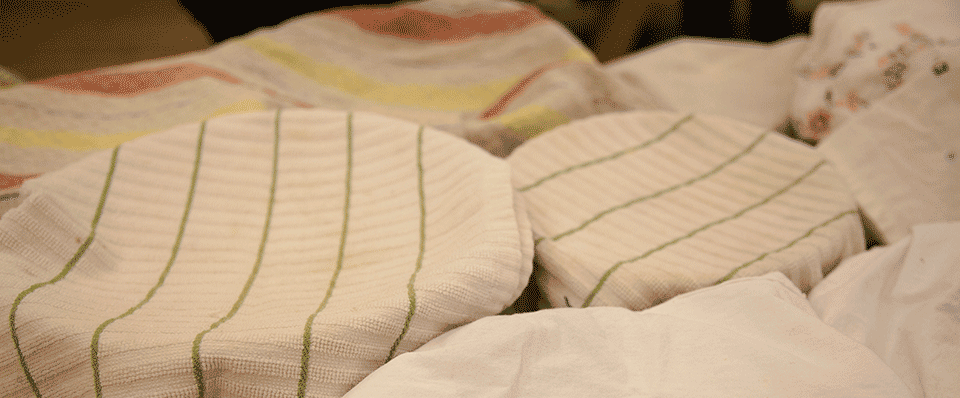
Covered with kitchen towels, a diverse group of mixing bowls — holding the rising dough — is sitting at the “rest” station during the bread-making event.
Educational hands-on events are the central focus of Test Kitchen for Change. In the beginning, I was investigating ways of creating opportunities for people to engage in slow-food processes. Slow Food is an international movement promoted as an alternative to fast food. The movement educates people about food preparation, about traditional and local cuisine, and about how to grow local ingredients. I tried to find support to test and implement non-traditional food services, such as a mobile kneading service, a small community-supported bakery, and even a small-business model. However, in order to make an impact on a particular local community, I decided to conduct small events. Small-group bread-making classes can be conducted without a special kitchen space, large equipment, or health department permits. By providing the main ingredients—flour, special yeast culture, and live instructions—I can inspire people to use what they already have to make bread.
There is no shortage of recipes and on-line tutorials, yet it took me some time and practice to make loaves that were not brick-hard (though they
tasted great due to the slow fermentation). Eventually, I reached out to real experts, Atwaters Bakery, a well-known artisanal bread-maker in Baltimore. They let me work one bread-making shift in their commercial bakery. I shaped dozens of loaves by hand and watched experts gracefully make and bake loaves. By kneading the dough, I learned to understand how it should feel and behave. I understood that to engage people in the process of making bread, I needed to design my program to provide hands-on experience.
At the educational events conducted by Test Kitchen for Change, participants learn that healthy and delicious bread can be made at home with little time commitment. The process of sourdough bread-making consists of small steps performed between long stretches of time, which can allow someone to live a fast and busy life while engaging in slow-food processes. I customized my project to suit the different audiences and locations for my events.
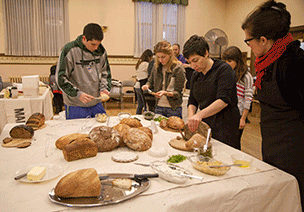
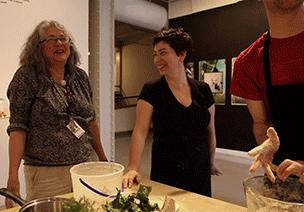
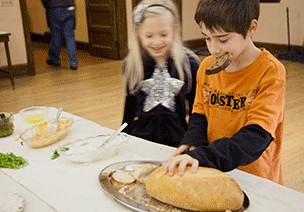
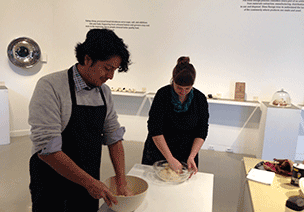
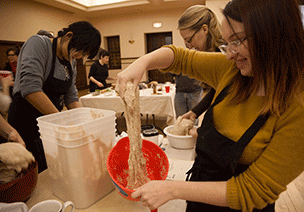
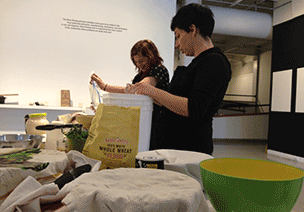
Bread 1, November 17, 2012
At the first bread-making event, I used a commercial kitchen to mix enough dough for over 50 loaves of bread. I transported the container with rising dough to another location where participants shaped the loaves. I hoped that participants would enjoy shaping the elastic dough, and this would make them interested in learning more. The event was held at the beautiful old Brown Memorial Park Avenue Presbyterian Church. The sanctuary features a walking labyrinth and stained glass windows designed and produced by the Tiffany Company. A church volunteer introduced visitors to meditative techniques that were a great addition to the experience of shaping loaves and to the larger theme of slowing down to savor life. Visitors enjoyed tasting fresh bread (most of it donated by the Atwaters bakery) and learning about bread-making techniques and tools.
pecial containers of the live starter culture, with instructions, were distributed to people at the event. Free bread recipes, videos, web resources, and personal support by e-mail were parts of the overall Test Kitchen for Change activities. People shaped the bread, decorated spoons, and watched bread-making videos. Even kids made dough sculptures and played with dough.
The next morning, participants came to pick up their loaves. The surplus bread was donated to the Brown Memorial Park Avenue Church for their charity events and even used in services. It was a beautiful and well-attended event. Bread One provoked some interesting discussions about bread. Participants expressed a desire to see the entire process, not just the bread-shaping part.
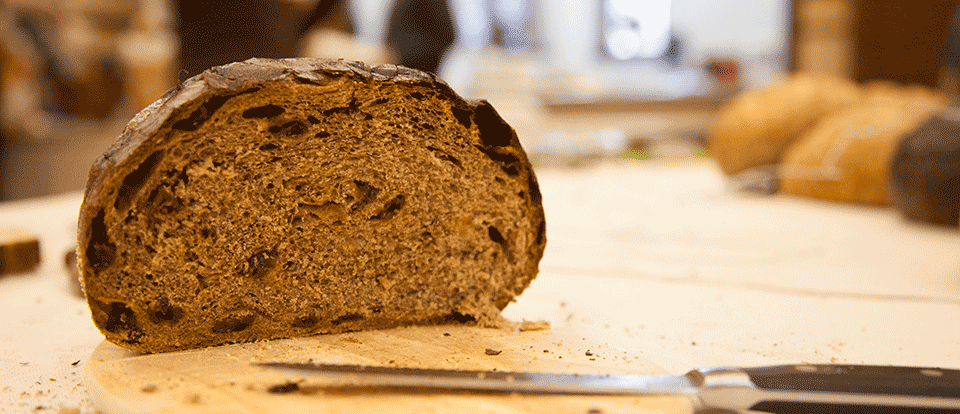
Bread 2, January 26, 2013
I collaborated with the Station North Co-operative Garden and the Lovely Lane Church for the second event, which attracted many people from the community. This event was advertised as a “bring your own mixing bowl” class. It was an even more successful experience. Participants added seeds, greens, and spices when they were mixing their own bread. It was wonderful to see a diverse group of mixing bowls holding rising dough covered with kitchen towels all sitting on a “rest” station. One participant wrapped his bowl with his jacket to keep it warm on a January afternoon. People mixed the dough and took their creations home to rise and bake. They emailed me photographs with captions: “my first loaf,” “tastes great,” “too much flax seed,” and “waiting to cool, smells wonderful.”
Meeting people at the events and teaching them about bread taught me that people are very eager to learn and try new things. Being a designer, I jumped at the opportunity to curate and design a collection of objects to explore at the event.
I collected, borrowed, and made containers and tools in order to educate people about bread, yeast, malt, wheat sprouting, and wild foods. I named my collection the Bread Zoo; the objects, along with books, videos and jars of sprouted grains, comprised a small bread museum. People spent time looking at the specimens during the events. They learned that sprouted grains are called malted and can be dried and milled into flours or added to bread as is. The seeds of the common plantain, wild buckwheat, and roasted roots of the chicory and dandelion plants were just a few wild ingredients that could easily be integrated into the bread. During the second bread-making event, the members of St. Paul Co-operative garden educated and recruited people to help them design and build an outdoor cooking oven. Inspired by our collaborative event, they are hoping to generate even more food-centered activity and to build a learning center right in the garden. Currently, we are planning more bread-making and pizza-making events in the garden.
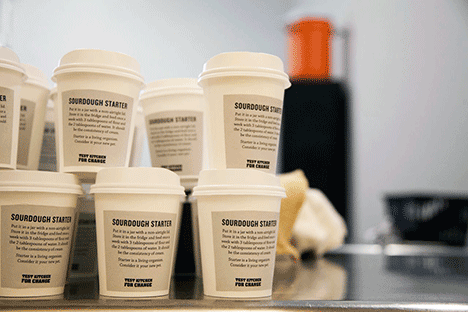
Sourdough starter is a community of local yeast cultures captured from the air and is different from the mono-culture, commercial, factory-made yeast. Test Kitchen for Change distributes active sourdough starter for free.
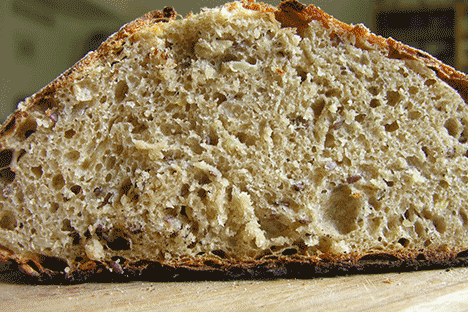
Bread 3, April 1- 4, 2013
Conducting experimental bread-making classes during the thesis show at the Meyerhoff Gallery gave me opportunity to refine hands-on events even more. Small, three- or four-person classes met several times a day in the gallery. 5–10 minutes intervals spaced in between longer periods of time illustrated to the participants that nature (yeast and time) is doing most of the work in bread-making. First, time relaxes the dough, making it elastic, and later, during the fermentation, time leavens dough slowly. The bread becomes rich in flavor and nutrients, and the process does not require the use of electricity to power speed mixers or aerators. There are no additives or preservatives. The ingredients are whole and unbleached wheat flours, water, salt, and yeast. The process requires only human touch, time, and any home oven. Classes in the gallery engaged participants and occasional viewers. We had to schedule additional one-on-one classes to accommodate even more interested participants. Since this particular event was in a gallery, I created a special outlet for participants to showcase their “first loaves.” Makers were asked to bring back one slice to be displayed in a special vitrine, along with a handwritten narrative about the experience.
“She baked me,” and “My dad ate all the bread,” were two of the comments. The display was filled with an assortment of slices. Every slice was a unique cross-section of the bread, and the bread slices, together with the written comments, sketched portraits of the makers. I am eager to learn how to make such events even better. For example, I learned that people’s ovens are very different, and some first-time bakers need more detailed recipes and instructions. I have designed, made, and distributed special baking stones to the participants of the Bread 3 classes. Currently, I am researching and experimenting with other techniques of heat distribution in order to help people bake better bread. This project was an opportunity to use my design skills, such as making, problem-solving, and communicating, to tackle a new situation— introducing slow process into fast lives. I was inspired by the slow design movement which advocates careful design in order to improve human experiences. Designing experiences, not artifacts was a big shift in my design thinking. Paraphrasing John Thakara, I tried to “design people in, not out of the system”. This notion of people as active participants made me reexamine my role as a designer.
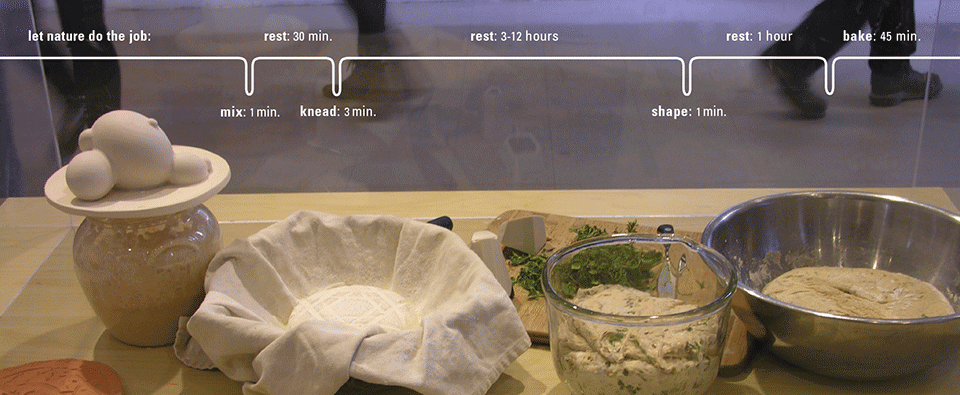
It was hard to resist the desire to jump to conclusions and start designing solutions. Yet only when I started prototyping the events by doing them, was I able to identify opportunities for design interventions, including objects, pieces of communication, and tools. These opportunities may seems small compared to the big idea of changing the world with design, yet that has allowed me to keep my project real. Test Kitchen for Change is a simple idea, yet there are many components to it that speak to larger issues such as health and nutrition, local and self sufficient living, ecology, balance, community, food access, and education.
Designers should be flexible yet persistent. Since I was not solving a particular problem, but had immersed myself in a situation with an open mind, new opportunities materialized. Using the design language, l treated the events as “prototypes” and the whole project, as the name suggests, an experiment. I did not know what the end-result would be, if any. The bread-making events were the concept, the process, and the outcome of the design. I will continue to collaborate with other like-minded people, conduct more events, reach out to all kinds of different communities. Using the design language, I will keep iterating.
